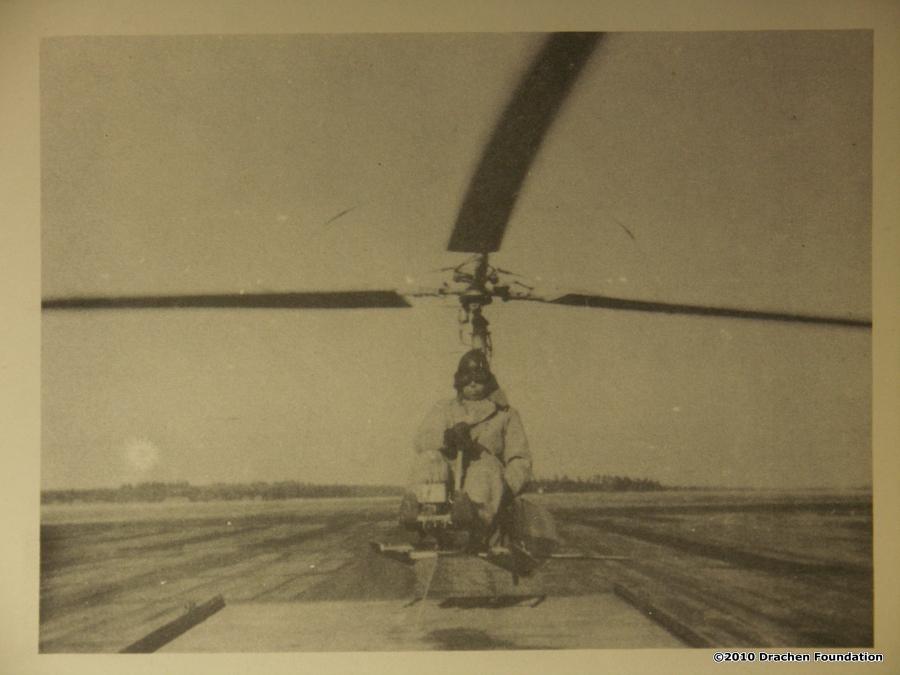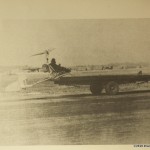Having attended the High Altitude Wind Power symposium at California State University in Chico, I was surprised at the variety of high altitude energy systems proposed by presenters and attendees (www.hawpconference.org). Of the many proposals, however, I was struck by the possibility of using tethered autogiros in high altitude energy generation. Here is a “kite” that can remain stable in almost any wind condition, is completely resistant to gust and shear, and produces great lifting capability in a fairly compact package. But the symposium made me think of a brief report on another autogiro – the “rotary wing kite” used on German submarines in WWII.
An easily overlooked item in the Drachen Foundation archive is a copy of the report by the Combined Intelligence Objectives Sub-Committee, written by Bartram Kelly and Hugh J. Mulvey, on behalf of the US Technical Industrial Intelligence Committee. It is a short summary of the information known about the German rotary wing kite used by submarine forces as an early warning system. Here was a system that could be deployed quickly and easily, was very difficult to “see”, and could be recovered to a submarine ready to submerge. The 25 page intelligence report describes the kite:
The FA 330 kite consists of pilot seat, pylon, conventional autogiro head rotor, tube extending aft supporting horizontal surface, and rudder operated by pilot’s feet. Great ingenuity in detail design is evident and the whole kite could be dismantled and stowed in a compartment on the submarine….
The English performed flight tests with a captured autogiro and reported the following flight performance:
The machine is launched with a slight backward tilt. Starting rope not always necessary. Typical airspeed is 25 mph. Minimum airspeed to maintain in flight is about 17 mph. Typical rpm is 205. Helicopter pilots find it easy to fly, and it is believed that several seamen learned to fly it on each submarine. The machine inspected has a bullet hole through the pylon. Hands off the stick for 5 to 10 seconds possible. In operation, from 200 to 500 feet of cable were used, although these heights have not yet been reached in tests….
The quick recovery of the kite was also discussed, as this was critical for the safety of the sub:
The pilot can telephone to the deck of the submarine. He can also operate a quick release which disconnects the cable at the kite. To overcome the difficulty of landing in water under a rotor, there is another emergency control lever over the pilot’s head. When he pulls it, the rotor flies away upwards and the parachute (stored immediately behind the pylon) is pulled up by the departing rotor and opens. The cable is automatically released, and the pilot, still strapped to the seat, is also directly connected to the open parachute. At this point he unfastens the safety belt and the entire fuselage structure falls down into the sea, leaving him descending alone by parachute.
What a horrible situation!
The report contains both diagrams and photographs of the autogiro and in them you can clearly see how compact and fragile this aircraft was. Maybe the best photos show a British airman flying the kite from the back of a flat-bed truck. Exciting indeed! German source documents have far more detail included, but It’s interesting to read this report, as it’s evident that the Allies had a great deal of respect for the ingenuity and cleverness shown in this simple system. They say, “Conventional autogiro practice was followed, the blades were exceptionally well made and great ingenuity in detail was shown, especially in regard to quick disassembly for storage, ease of blade pitch and damper adjustments, etc.”
Scott Skinner
Board President
Drachen Foundation







